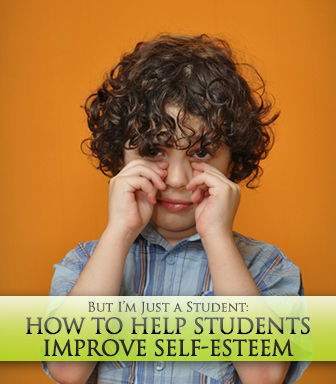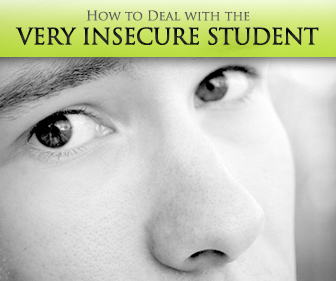But Iím Just a Student: How to Help Students Improve Self-Esteem


Teacher staff rooms are rife with tales of the demands and inflated view of their own abilities from entitled students. This may, however, be more of an American phenomenon: the United States, after all, has traditionally placed a high value on confidence and self-esteem. ESL students, however, often come from cultures that value modesty and respect of others over confidence and self-respect. In some ways, this comes as a welcome relief: the student who acknowledges the teacher might just know more than herself in the specific area of study. However, there are instances when the student is so self-effacing, insecure, and apparently lacking in self-worth that it is cause for concern for both the student’s education and overall well-being. What are some of the signs of critical insecurity and what are the ways to address it if it is actually interfering with the student’s ability to learn?

I say “problematic” because while many people may be insecure—in fact, most people, in specific situations—it is only a problem if it is to a degree that it is interfering with the student’s ability to learn and function. Following are some of the signs that a student whose insecurity is problematic.
One of the major signs of a student with problems with self-esteem is that she “hides out” in the back of the class, where the teacher can’t see her (or so she thinks) , and where other students find it difficult to interact with her. She may also put up a “wall” of books or electronic devices, such as laptops or cell phones, that prevent the teacher or other students from interacting with her. Excessive use of electronics in class is often regarded by instructors as simply rude, but often it is used a vehicle to avoid social intercourse—the student is so involved with the device or book that she is relieved of interacting with people face-to-face.
Another sign of a student struggling with self-esteem is that he is extremely apologetic for asking for anything: for example, apologizes repeatedly for “imposing” on a couple of moments of the instructor’s time. In fact, the repeated use of the phrase “I’m sorry,” often in inappropriate situations for which the individual should feel no responsibility or guilt, is a strong sign of an insecure individual anywhere.
In some cultures—including in the United States, at least traditionally—it is expected to shrug off compliments or accomplishments, as bragging about them seems rude. Therefore, students who do this—“Oh, that’s okay; I’m not really all that good a writer, but I try hard”—are often just engaging in an expected show of modesty. However, if a student repeatedly pushes asides compliments over every achievement, she may actually be struggling with feelings of self-worth, really seeing nothing remarkable in her abilities or actually seeing them as drawbacks.
Just as a student who is truly insecure may dismiss his real accomplishments, he may also focus excessively on a set of real or imagined shortcomings that are often minor in nature: poor handwriting or organizational skills, old clothes, lack of athletic ability, and so forth. Again, a student who makes a minor joke about a short-coming: “Oh, I am such an airhead; I forget everything,” may be just engaging in a show of conventional self-effacement, but if seems habitual, there may be more underlying concerns involved.
Again, all of these symptoms may indicate a lack of self-esteem. If they are extreme, they may actually be symptoms of underlying depression, and the teacher may consider referring the student to counseling services. Otherwise, if the insecurity seems mostly related to academic work, there are some ways the instructor can address it within the confines of the class. Since most students suffer from varying degrees of insecurity at different times, these methods are likely to benefit the entire class and need not be focused on a particular student.

The following methods can help the entire class improve their academic self-confidence, which in turn creates a comfort zone and ability to learn as the student is not longer so focused on her alleged shortcomings and is freed up to learn the course content.
One of the best ways to improve self-esteem is to set up opportunities for successful interaction with others. Humans are by nature social creatures; hence our sense of self is heavily related to how well we integrate in a community. A sense of community can be achieved by setting up common goals for the class, such as completion of a major project related to English learning, and roles for each student toward that goal. The classes I remember most fondly are those that recognized my individual contribution to the class.
Recognizing the individual student’s value to the group is another way to build self-esteem: it is extremely validating to have one’s individual achievements acknowledged, such as how a student’s graphic skills really contributed toward the class website. This recognizes both the student’s individuality as well as the contribution to the group.
Finally, a major way to build student self-esteem within an academic setting is to teach such study skills as keeping a calendar of due dates, skimming text for efficient reading, outlining compositions, and distinguishing between reliable and unreliable sources. Recognizing they are in control of their own learning, rather than dependent on the goodwill of the teacher, empowers students and builds their self-esteem.
The results, however, in students who recognize their value as learners and as members of a community are gratifying.
Do any of your students suffer from troublesome lack of self-esteem? What are methods for addressing it?